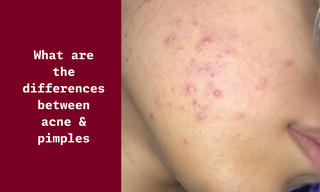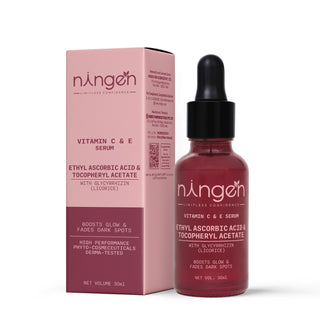Acne and pimples are common skin conditions that many people struggle with. While they may seem similar, are there any differences between the two? Understanding the distinctions between acne and pimples can help you better treat and manage your skin concerns.
Both acne and pimples are caused by clogged pores, but there are some key differences between the two. By knowing what sets them apart, you can take the necessary steps to prevent and treat them accordingly. Let's delve into the details and explore What are the differences between acne & pimples.
Dos & Don’ts if You Have Acne

What is Acne?
Acne is a common skin condition characterized by the presence of pimples, blackheads, and whiteheads on the face, neck, chest, and back. It occurs when hair follicles become clogged with oil and dead skin cells, leading to inflammation and the formation of blemishes. Acne can range from mild to severe and may cause discomfort and self-consciousness
Types of Acne
- Whiteheads: Whiteheads are a type of acne that occurs when pores become clogged with oil, dead skin cells, and bacteria. They appear as small, white or flesh-colored bumps on the skin's surface and are often surrounded by redness or inflammation.
- Blackheads: Blackheads are similar to whiteheads but have a dark appearance. They form when the pore is only partially blocked, allowing the trapped oil and dead skin cells to oxidize and turn black. Blackheads typically appear as small, dark dots on the skin, often on the nose, chin, and forehead.
- Papules: Papules are small, red, raised bumps on the skin that are often tender to the touch. They occur when the walls of the pores break down, causing inflammation and swelling. Papules do not contain pus and should not be squeezed or popped, as this can lead to further irritation and scarring.
- Pustules: Pustules are similar to papules but contain pus. They appear as red, inflamed bumps with a white or yellow center. Pustules are often referred to as "pimples" and can be painful or tender. It is important to avoid picking or popping pustules, as this can worsen the inflammation and increase the risk of scarring.
- Nodules: Nodules are larger, solid, and painful lumps that develop deep within the skin. They are a more severe form of acne and occur when clogged pores become infected and inflamed. Nodules are often characterized by their firm texture and can take a long time to heal. They may leave behind scars or dark spots after they resolve.
- Cysts: Cysts are the most severe form of acne and are large, painful, pus-filled lesions that develop deep within the skin. They are often caused by a combination of bacteria, oil, and dead skin cells. Cysts can be red, swollen, and tender to the touch. They have the potential to cause significant scarring if not treated properly.
It is important to note that acne can vary in severity and may present as a combination of different types. Consulting with a dermatologist can help determine the appropriate treatment plan for individual acne concerns.
What Are Pimples?
Pimples are small inflammations or infections of the skin that occur when hair follicles become clogged with oil, dead skin cells, and bacteria. They typically appear as red, raised bumps on the skin and can be filled with pus. Pimples can occur on the face, neck, chest, back, and shoulders, and are most common during puberty due to hormonal changes. Factors such as excess oil production, bacteria, hormonal imbalances, certain medications, and genetics can contribute to the development of pimples.
Differences Between Acne & Pimples
Acne and pimples are both common skin conditions that can cause blemishes on the skin, but they have some key differences:
- Definition: Acne is a broader term that refers to a chronic skin condition characterized by the occurrence of pimples, blackheads, whiteheads, and other types of blemishes. Pimples, on the other hand, are a specific type of acne lesion that occurs when hair follicles become clogged with oil, dead skin cells, and bacteria.
- Severity: Acne can range from mild to severe, with varying degrees of inflammation and the presence of different types of blemishes. Pimples, however, are typically milder and localized, appearing as small red bumps on the skin.
- Location: Acne can occur on various parts of the body, including the face, chest, back, and shoulders. Pimples are most commonly found on the face, particularly on the forehead, nose, and chin.
- Causes: Acne is usually caused by a combination of factors, including hormonal changes, excess oil production, clogged pores, bacteria, and inflammation. Pimples are primarily caused by the clogging of hair follicles with oil, dead skin cells, and bacteria.
- Duration: Acne is a chronic condition that can last for months or even years, with recurring flare-ups. Pimples, on the other hand, tend to be more temporary and may resolve within a few days or weeks.
- Treatment: Both acne and pimples can be treated with similar approaches, such as topical creams, cleansers, and medications. However, severe acne may require more aggressive treatments, including oral medications or procedures performed by dermatologists.
Overall, acne is a broader term that encompasses various types of blemishes, including pimples. Pimples, on the other hand, are a specific type of acne lesion characterized by localized red bumps on the skin.
Causes of Acne & Pimples
- Hormonal changes: Hormonal fluctuations, especially during puberty, can stimulate the production of sebum, an oily substance that can clog pores and lead to acne and pimples.
- Excess oil production: Overactive oil glands can produce more oil than necessary, leading to clogged pores and acne breakouts.
- Bacteria: Propionibacterium acnes, a bacteria that naturally resides on the skin, can multiply and cause inflammation when trapped in clogged pores, resulting in acne.
- Dead skin cells: The shedding of dead skin cells can mix with excess oil, clogging pores and leading to the formation of pimples.
- Certain medications: Some medications, such as corticosteroids or lithium, can trigger acne breakouts as a side effect.
- Diet: Consuming a diet high in refined carbohydrates, sugary foods, and dairy products has been linked to an increased risk of developing acne.
- Stress: Stress can stimulate the production of hormones like cortisol, which can increase oil production and lead to acne breakouts.
- Genetics: Acne and pimples can be influenced by genetic factors, with a family history of acne increasing the likelihood of developing it.
- Environmental factors: Exposure to certain pollutants, humidity, and excessive sweating can contribute to clogged pores and acne breakouts.
- Poor skincare routine: Not properly cleansing the skin, using harsh skincare products, or frequently touching the face can aggravate acne and pimples.
Symptoms of Acne and pimples
Symptoms of Acne:
- Blackheads and Whiteheads:
- Blackheads (open comedones): Small, dark bumps on the skin's surface.
- Whiteheads (closed comedones): Similar, but covered with a thin layer of skin, appearing as small, flesh-colored bumps.
- Papules and Pustules:
- Papules: Small, red bumps without pus.
- Pustules: Red bumps with pus at the top.
- Nodules and Cysts:
- Nodules: Large, painful lumps beneath the skin's surface.
- Cysts: Deep, painful, pus-filled lumps that can cause scarring.
- Inflammation and Redness:
- Inflamed areas with redness, tenderness, and swelling.
- Oily Skin:
- Excessive oil production contributes to clogged pores.
- Scarring:
- Acne lesions may leave scars, especially if not treated properly.
Symptoms of Pimples:
- Redness and Swelling:
- Localized redness and swelling around the affected area.
- Pus-Filled Bumps:
- Small, raised bumps with a white or yellow center containing pus.
- Tenderness:
- Sensitivity or pain when touching the pimple.
- Occasional Itching:
- Some individuals may experience mild itching around the pimple.
- Temporary Nature:
- Pimples are often temporary and may come and go.
It's important to note that both acne and pimples can vary widely in severity, and individual experiences may differ. Seeking professional advice for persistent or severe cases is recommended.
Prevention of Acne and pimples
Acne and pimples are common skin conditions that can be prevented effectively with the following methods:
- Cleanse your face twice a day: Use a gentle cleanser to wash your face in the morning and evening. This helps to remove excess oil, dirt, and bacteria that can contribute to acne.
- Avoid touching your face: Touching your face with dirty hands can transfer bacteria and oil to your skin, leading to breakouts. Try to avoid touching your face throughout the day.
- Use non-comedogenic skincare products: Look for skincare products that are labeled as non-comedogenic, meaning they won't clog your pores. These products are less likely to cause acne or make existing acne worse.
- Use topical treatments: Over-the-counter topical treatments containing ingredients like benzoyl peroxide or salicylic acid can help to reduce acne and pimples. These ingredients work by killing bacteria, unclogging pores, and reducing inflammation.
- Avoid picking or popping pimples: Picking or popping pimples can lead to scarring and further inflammation. It's best to leave them alone and let them heal naturally.
- Maintain a healthy diet: Eating a balanced diet with plenty of fruits, vegetables, and whole grains can help to support healthy skin. Avoiding excessive consumption of sugary and greasy foods may also help to reduce acne.
- Keep your hair clean: If you have oily hair, make sure to wash it regularly and keep it away from your face. Oily hair can contribute to acne by transferring oil and bacteria onto your skin.
- Manage stress levels: High levels of stress can worsen acne and pimples. Practice stress management techniques like exercise, meditation, or deep breathing exercises to help keep stress levels in check.
- Avoid excessive sun exposure: While a little sun exposure can help to dry out acne, too much can lead to skin damage and potentially worsen acne in the long run. Use non-comedogenic sunscreen when spending time outdoors.
- Consult a dermatologist: If over-the-counter treatments are not effective or if you have severe acne, it's best to consult a dermatologist. They can provide personalized treatment options such as prescription medications or in-office procedures to help clear your skin.
Treatment of Acne and pimples
Treatment of Acne:
- Topical Retinoids:
- Prescription or over-the-counter creams containing retinoids to unclog pores and promote cell turnover.
- Antibiotics:
- Oral or topical antibiotics to reduce inflammation and control bacteria.
- Benzoyl Peroxide:
- Over-the-counter medication that kills bacteria and helps to clear blocked oil glands.
- Salicylic Acid:
- Topical treatment to exfoliate the skin and unclog pores.
- Hormonal Therapies:
- Birth control pills or anti-androgen medications for hormonal acne in women.
- Isotretinoin (Accutane):
- A potent oral medication for severe, persistent acne, prescribed under strict medical supervision.
- Lifestyle Changes:
- Maintaining a consistent skincare routine, avoiding harsh products, and practicing good hygiene.
- Chemical Peels and Laser Therapy:
- In-office procedures to reduce acne lesions and improve skin texture.
- Corticosteroid Injections:
- For treating large, painful acne nodules.
- Proper Skincare:
- Regular cleansing, avoiding excessive sun exposure, and using natural, chemical-free, non-comedogenic products.
Treatment of Pimples:
- Topical Treatments:
- Over-the-counter creams with benzoyl peroxide or salicylic acid to reduce inflammation.
- Warm Compress:
- Applying a warm compress to the affected area can help reduce swelling and promote drainage.
- Avoid Picking:
- Refrain from squeezing or picking pimples to prevent infection and scarring.
- Antibacterial Cleansers:
- Use gentle cleansers containing antibacterial agents.
- Tea Tree Oil:
- Applying diluted tea tree oil, known for its antimicrobial properties.
- Over-the-Counter Spot Treatments:
- Creams or gels containing sulfur or resorcinol for targeted treatment.
- Honey and Aloe Vera:
- Natural remedies like honey or aloe vera with anti-inflammatory properties.
- Stay Hydrated:
- Drinking plenty of water to maintain skin hydration.
- Proper Diet:
- A balanced diet with fewer processed foods and sugar.
- Consult a Dermatologist:
- Seek professional advice for persistent or severe cases, especially if accompanied by pain or scarring.
Individual responses to treatments vary, and consulting a dermatologist can help tailor a plan to specific needs.
Why Ningen products are safe for acne & pimples?
Ningen products are crafted with a meticulous focus on skin health, making them exceptionally safe for acne and pimples. Our formulations feature gentle yet effective natural ingredients known for their anti-inflammatory and antibacterial properties. The absence of harsh chemicals and comedogenic substances ensures that Ningen products do not exacerbate acne. Instead, they work synergistically to soothe irritated skin, regulate oil production, and promote a clearer complexion. Rigorous testing and adherence to dermatological standards underscore our commitment to creating a skincare solution that is not only safe but actively beneficial for those dealing with acne and pimples.
Takeaway
In summary, differentiating between acne and pimples is essential for effective skincare. Although these terms are often used interchangeably, acne is a broader condition encompassing various skin issues, including pimples. Acne, a chronic inflammatory condition, results from excess oil, clogged pores, and bacterial growth. Pimples, a specific type of acne lesion, are raised red bumps. Recognizing these differences empowers individuals to make informed skincare decisions and seek appropriate treatments. Consulting a dermatologist is crucial for personalized advice and effective management of skin health.
Frequently Asked Questions:
Question 1: Can stress cause acne?
A: Yes, stress can contribute to acne. Elevated stress levels may stimulate the production of hormones that increase oil production, leading to clogged pores and breakouts. Managing stress is crucial for maintaining clear skin.
Question 2: At what age can you get acne?
A: Acne can develop at any age, but it's most common during puberty and adolescence. Hormonal changes trigger increased oil production, leading to breakouts. However, adults can also experience acne due to factors like hormonal fluctuations, stress, or underlying health issues.
Question 3: What is adult acne?
Answer: Adult acne refers to the occurrence of acne breakouts in individuals beyond their teenage years. It can result from hormonal fluctuations, stress, genetics, or underlying health issues. The symptoms and treatment may differ from adolescent acne, often requiring tailored skincare routines or medical intervention.
Question 4: Does diet affect acne?
Answer: Yes, diet can influence acne. Certain foods, especially those high in refined sugars and dairy, may exacerbate breakouts in some individuals. However, the impact varies, and a balanced diet with adequate nutrients plays a crucial role in maintaining overall skin health. Consulting a dermatologist for personalized advice is recommended.
Question 5: Can I use make-up if I have acne?
Answer: Yes, you can use makeup if you have acne. Opt for non-comedogenic, oil-free products. Ensure thorough removal, choose products labeled "acne-friendly," and consider mineral makeup. Prioritize skincare, and consult a dermatologist for tailored advice on managing acne while using makeup.
Question 6: Are acne and pimples caused by the same factors?
Answer: Yes, both acne and pimples can be caused by factors such as excess oil production, clogged pores, bacteria, and hormonal changes. Acne represents a spectrum of skin issues, while pimples are one specific manifestation.
Question 7: Can acne be more severe than a few pimples?
Answer: Yes, acne can range from mild to severe, involving various types of blemishes like blackheads, whiteheads, cysts, and nodules. Pimples are just one form of acne lesion.









